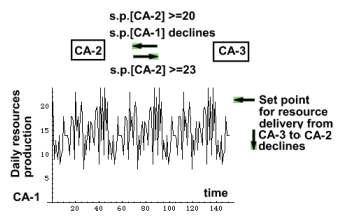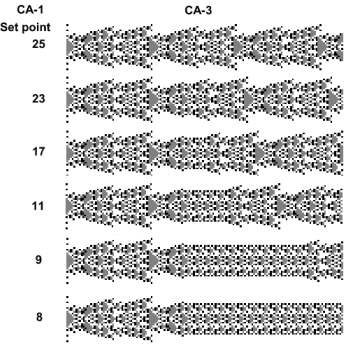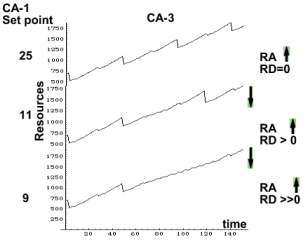 |
CA
induced differentiation
The present
experiment is a continuation of the previous one. Now the proliferon consists of three processes. The
set points of CA-2 and CA-3 are respectively >= 20, >=23. In addition
a declining set point which is triggered by CA-1 daily production, determines the
frequency of resource delivery from CA-3 to CA-2.
 |
 |
The last image
illustrates the mechanism behind the CA-3 structure change. As the CA-1
set point declines CA-3 is triggered more often to deliver
resources to CA-2. The resources
of some cells are depleted, they die and CA-3 structure changes. The outcome depends
on two rates. Resource accumulation (RA)
and depletion (RD). The isolated CA (s.p. 25)
merely accumulates resources and its structure does not change.
At lower set points RD becomes more pronounced and for short periods
CA-3 structure changes. As the set point declines it triggers more and
more resource deliveries from CA-3 to CA-2 and the change in its structure
becomes more pronounced.
 |
The stem process
(CA-1) is isolated and does not deliver resources. It only triggers transitory
processes (CA-2, CA-3) to do so. Initially CA-3 is undifferentiated. As
the set point declines, CA-3 becomes more and more similar to CA-2. In
other words it differentiates to the CA-2 state.
Passage
through the solution space
Initially
the proliferon solution consists of an oscillating CA-2 and
an isolated CA-3. Then CA-1 triggers a differentiation which promotes
the proliferon to a new solution (attractor) in which both transient processes
have the same structure. Thus the entire proliferon differentiates from
one solution to another.
Tolerance
to change
Resources of a process determine its resistance or tolerance
to change. CA-1 triggering was
initiated at the beginning of the experiment. However,
if the experiment would have started after CA-3 had accumulated more resources
RA >> RD, and CA-3 would not have differentiated.
Setup
nca=3; restoreparams[1,1,1]; restoreparams[2,1,1]; restoreparams[3,1,1];
If[sa[[2]] >=23 ,donate[3, 2]]; If[ sa[[3]] > sa[[2]] &&
sa[[2]] >= 20 && sa[[1]] >=k, donate[3, 2]]; {k,, 23, 2,
-1}; If[nowdat[[no,8]] <= 2, newzygote[no]];